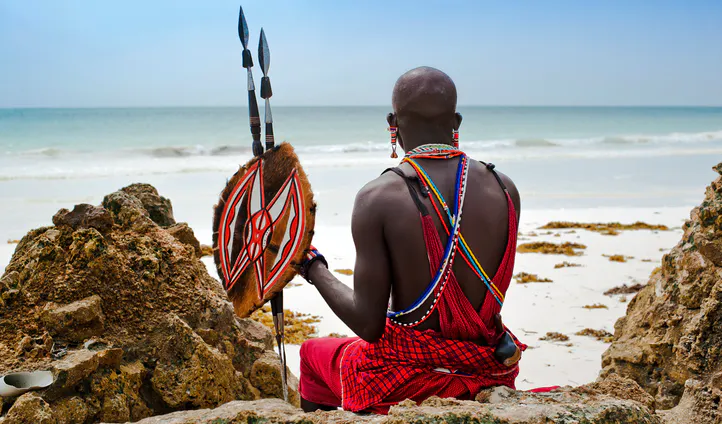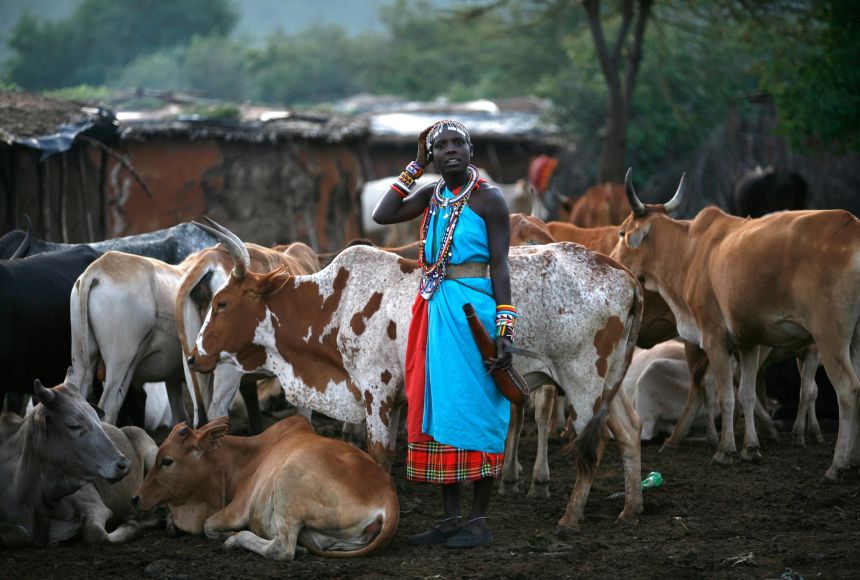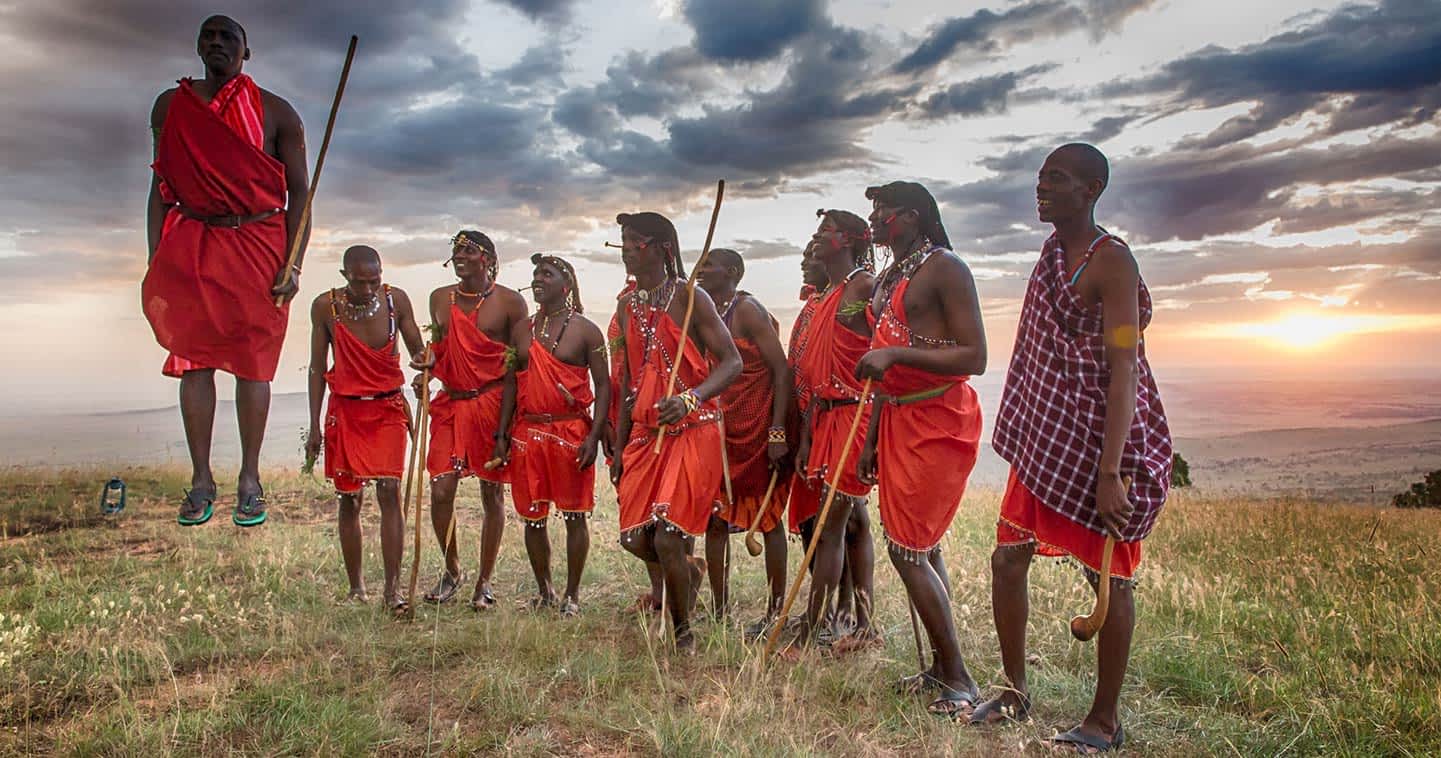The Maasai Culture and Traditions

The Maasai Tribe
The Maasai are an indigenous ethnic group in Africa of semi-nomadic people settled in Kenya and northern Tanzania. Due to their distinct traditions, customs and dress and their residence near the many national game parks of East Africa, the Maasai are among the foremost African ethnic groups and are known internationally because of their links to the national parks and reserves.
Language - Maa, a language derived from Nilo-Saharan, related to Dinka and Nuer. They also speak the official languages of Tanzania and Kenya. Swahili and English.
Population - The Maasai population is now estimated 900 000
Although the Kenyan and Tanzanian governments have established programs to encourage the Maasai to leave behind their traditional semi-nomadic lifestyle, the Maasai people have carried on their age-old customs. However this is changing, albeit slowly. Maasai History According to the tribe's own oral history, the Maasai originated north of Lake Turkana (north-west Kenya) in the lower Nile Valley. They began migrating south in the 15th century and arrived in the long trunk of land stretching across central Tanzania and Northern Kenya during the 17th and 18 century. The Maasai territory reached its most dominant size in the 19 century when they covered most of the Great Rift Valley and adjacent lands from Dodoma and Mount Marsabit.
At this time the Maasai raided cattle far across the east at Tanga Coast in Tanzania. They used shields and spears, but were most feared for throwing orinka (clubs) which could be expertly thrown from up to 70 paces (approximately 100 meters).
The report of concentrated Maasai warriors told of their moving to Kenya in 1852, after depopulating the Wakuafi Wilderness in southeastern Kenya, the Maasai warriors threatened Mombasa, on Kenya's coast.
The result of this migration lead to the Maasai now being the southernmost Nilotic speakers.
The Maasai 'Emutai' of 1883-1902 came after the time of expanding. This period was scarred by epidemics of smallpox, contagious bovine pleuropneumonia and rinderpest. The estimated 90 per cent of cattle and half of wild species perished from rinderpest. This drastic period coincided with drought. The rains neglected the lands completely in 1897 and 1898. Commencing with a 1904 treaty and followed by another treaty in 1911, Maasai lands in Kenya were cut down by 60 percent when the British evicted them to allow space for settler ranches thus confining the Maasai people to present-day Narok and Kajiado districts.
Maasai in Tanzania were forced out from their fertile lands between Mount Kilimanjaro and Mount Meru and most of their fertile mountainous regions near the Ngorongoro in the 1940s. More land was claimed to create national parks and wildlife reserves. Masai Mara, Samburu, Ngorongoro, Amboseli, Nairobi National Park, the Serengeti, Lake Nakuru, Manyara and Tarangire.
Maasai are traditionalist and have resisted the urging of the Kenyan and Tanzanian governments to adopt a more modern lifestyle. The Maasai have rightfully demanded pasturing and grazing rights to several of the national parks in both Tanzania and Kenya.
The Maasai tribe stood firm against slavery and lived alongside most of the land's wild animals with an aversion to eating birds and game. Maasai land now boasts East Africa's finest nature and wildlife areas.
Maasai Shelter The Maasai, historically a nomadic people, have traditionally relied on readily available materials and indigenous technology to construct their unusual and interesting housing. The traditional Maasai house was designed for people on the move and thus their houses were very impermanent in nature. The Inkajijik (houses) are either circular or loaf-shaped, and are made by women.
Their villages are enveloped in a circular Enkang (fence) built by the men and this protects their cattle at night from wild animals. Maasai Culture Maasai society is firmly patriarchal in nature, with elder Maasai men sometimes joined by retired elders, determining most major matters for the Maasai tribes. The Maasai people are monotheistic, and their God is named Engai or Enkai.
For Maasai people living a traditional way of life, the end of life is virtually without a formal funeral ceremony, and the dead are left out in the fields for scavengers. Burial has in the past been reserved for great chiefs only, since it is believed by the Maasai that burial is harmful to the soil.
Traditional Maasai people's lifestyle concentrates on their cattle which make up the primary source of food. Amongst the Maasai and several other African ethnic groups, the measure of a man's wealth is in terms of children and cattle. So the more the better.
A man who has plenty cattle but not many children is considered to be poor and vice versa. A Maasai myth says that God afforded them all the cattle on earth, resulting in the belief that rustling from other tribes is a matter of claiming what is rightfully theirs, a practice that has now become much less common. Maasai Music and Dance Traditionally, the Maasai music comprises of rhythms rendered by a chorus of vocalists singing harmonies, all the while the olaranyani (song leader) sings the melody. The olaranyani is usually the person who can best sing that song. The olaranyani starts singing the namba of a song and the group responds with one unanimous call in acknowledgment. Women recite lullabies, hum songs and sing music that praises their sons.
One elision to the vocal creation of Maasai music is the function of the horn of the Greater Kudu to summon morans (initiates) for the Eunoto ceremony (a coming of age ceremony). The ceremony usually lasts ten or more days. [And the singing and dancing around the manyattas involve flirting. Young men will line and chant and the women stand in front of them and sing in counterpoint to them. Contemporary Hip Hop musicians from northern Tanzania are now incorporating traditional Maasai rhythms, chants and beats into their music. Influence of the Modern World Government policies focusing on the preservation of their national parks and reserves, with the exclusion of the culturally rich Maasai tribe, have now made the traditional Maasai way of life increasingly difficult to maintain and preserve for coming generations to experience and learn about.
During recent years, projects have been implemented to help Maasai tribal leaders find a way to preserve their traditions and way of life while also trying to balance the education needs of the Maasai children for the modern world.
Many Maasai people have stirred away from the nomadic life to positions in business commerce and government roles. Yet despite the modernized urban lifestyle they lead, many Maasai' still happily head homewards clothed in designer brands, only to emerge from the traditional lands wearing their traditionally colourful shuka, cowhide sandals and with a wooden orinka in their hand- at ease with themselves and the world. Maasai Clothing Clothing varies by sex, age and place. Young men wear black for several months after their circumcision. Although, red is a favored color among the Maasai. Black, Blue, checkered and striped cloth are also worn, together with mulitcoloured African garments. In the 1960s the Maasai began to replace sheepshin, calf hides and animal skin for more commercial material. The cloth used to wrap around the body is the called Shúkà in the Maa language.
Language - Maa, a language derived from Nilo-Saharan, related to Dinka and Nuer. They also speak the official languages of Tanzania and Kenya. Swahili and English.
Population - The Maasai population is now estimated 900 000
Although the Kenyan and Tanzanian governments have established programs to encourage the Maasai to leave behind their traditional semi-nomadic lifestyle, the Maasai people have carried on their age-old customs. However this is changing, albeit slowly. Maasai History According to the tribe's own oral history, the Maasai originated north of Lake Turkana (north-west Kenya) in the lower Nile Valley. They began migrating south in the 15th century and arrived in the long trunk of land stretching across central Tanzania and Northern Kenya during the 17th and 18 century. The Maasai territory reached its most dominant size in the 19 century when they covered most of the Great Rift Valley and adjacent lands from Dodoma and Mount Marsabit.
At this time the Maasai raided cattle far across the east at Tanga Coast in Tanzania. They used shields and spears, but were most feared for throwing orinka (clubs) which could be expertly thrown from up to 70 paces (approximately 100 meters).
The report of concentrated Maasai warriors told of their moving to Kenya in 1852, after depopulating the Wakuafi Wilderness in southeastern Kenya, the Maasai warriors threatened Mombasa, on Kenya's coast.
The result of this migration lead to the Maasai now being the southernmost Nilotic speakers.
The Maasai 'Emutai' of 1883-1902 came after the time of expanding. This period was scarred by epidemics of smallpox, contagious bovine pleuropneumonia and rinderpest. The estimated 90 per cent of cattle and half of wild species perished from rinderpest. This drastic period coincided with drought. The rains neglected the lands completely in 1897 and 1898. Commencing with a 1904 treaty and followed by another treaty in 1911, Maasai lands in Kenya were cut down by 60 percent when the British evicted them to allow space for settler ranches thus confining the Maasai people to present-day Narok and Kajiado districts.
Maasai in Tanzania were forced out from their fertile lands between Mount Kilimanjaro and Mount Meru and most of their fertile mountainous regions near the Ngorongoro in the 1940s. More land was claimed to create national parks and wildlife reserves. Masai Mara, Samburu, Ngorongoro, Amboseli, Nairobi National Park, the Serengeti, Lake Nakuru, Manyara and Tarangire.
Maasai are traditionalist and have resisted the urging of the Kenyan and Tanzanian governments to adopt a more modern lifestyle. The Maasai have rightfully demanded pasturing and grazing rights to several of the national parks in both Tanzania and Kenya.
The Maasai tribe stood firm against slavery and lived alongside most of the land's wild animals with an aversion to eating birds and game. Maasai land now boasts East Africa's finest nature and wildlife areas.
Maasai Shelter The Maasai, historically a nomadic people, have traditionally relied on readily available materials and indigenous technology to construct their unusual and interesting housing. The traditional Maasai house was designed for people on the move and thus their houses were very impermanent in nature. The Inkajijik (houses) are either circular or loaf-shaped, and are made by women.
Their villages are enveloped in a circular Enkang (fence) built by the men and this protects their cattle at night from wild animals. Maasai Culture Maasai society is firmly patriarchal in nature, with elder Maasai men sometimes joined by retired elders, determining most major matters for the Maasai tribes. The Maasai people are monotheistic, and their God is named Engai or Enkai.
For Maasai people living a traditional way of life, the end of life is virtually without a formal funeral ceremony, and the dead are left out in the fields for scavengers. Burial has in the past been reserved for great chiefs only, since it is believed by the Maasai that burial is harmful to the soil.
Traditional Maasai people's lifestyle concentrates on their cattle which make up the primary source of food. Amongst the Maasai and several other African ethnic groups, the measure of a man's wealth is in terms of children and cattle. So the more the better.
A man who has plenty cattle but not many children is considered to be poor and vice versa. A Maasai myth says that God afforded them all the cattle on earth, resulting in the belief that rustling from other tribes is a matter of claiming what is rightfully theirs, a practice that has now become much less common. Maasai Music and Dance Traditionally, the Maasai music comprises of rhythms rendered by a chorus of vocalists singing harmonies, all the while the olaranyani (song leader) sings the melody. The olaranyani is usually the person who can best sing that song. The olaranyani starts singing the namba of a song and the group responds with one unanimous call in acknowledgment. Women recite lullabies, hum songs and sing music that praises their sons.
One elision to the vocal creation of Maasai music is the function of the horn of the Greater Kudu to summon morans (initiates) for the Eunoto ceremony (a coming of age ceremony). The ceremony usually lasts ten or more days. [And the singing and dancing around the manyattas involve flirting. Young men will line and chant and the women stand in front of them and sing in counterpoint to them. Contemporary Hip Hop musicians from northern Tanzania are now incorporating traditional Maasai rhythms, chants and beats into their music. Influence of the Modern World Government policies focusing on the preservation of their national parks and reserves, with the exclusion of the culturally rich Maasai tribe, have now made the traditional Maasai way of life increasingly difficult to maintain and preserve for coming generations to experience and learn about.
During recent years, projects have been implemented to help Maasai tribal leaders find a way to preserve their traditions and way of life while also trying to balance the education needs of the Maasai children for the modern world.
Many Maasai people have stirred away from the nomadic life to positions in business commerce and government roles. Yet despite the modernized urban lifestyle they lead, many Maasai' still happily head homewards clothed in designer brands, only to emerge from the traditional lands wearing their traditionally colourful shuka, cowhide sandals and with a wooden orinka in their hand- at ease with themselves and the world. Maasai Clothing Clothing varies by sex, age and place. Young men wear black for several months after their circumcision. Although, red is a favored color among the Maasai. Black, Blue, checkered and striped cloth are also worn, together with mulitcoloured African garments. In the 1960s the Maasai began to replace sheepshin, calf hides and animal skin for more commercial material. The cloth used to wrap around the body is the called Shúkà in the Maa language.

